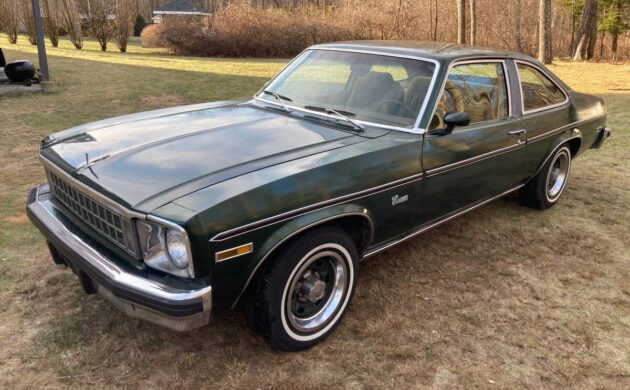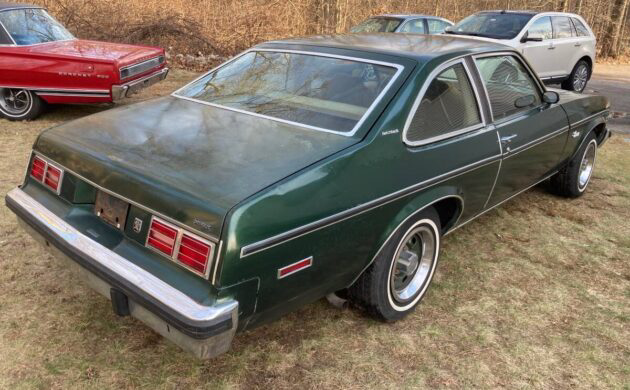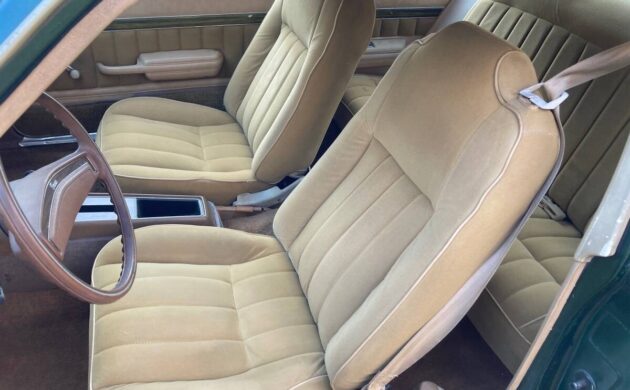The 1960s and 1970s rear-wheel-drive Nova was one of Chevrolet’s most popular automobiles. It would receive its final redesign in 1975, to be replaced by the troubled front-wheel-drive Citation in 1980. For 1976, there was a luxury version of the Nova dubbed the Concours, with a higher level of trim than your standard Chevy compact. This Concours is said to be a one-owner car and the seller has the 1976 title in hand. Other than some tired paint, this “Bow-Tie” may have a lot of life left. From Milford, Massachusetts, this V8 Nova is available here on craigslist for $8,700. Thanks for keeping us flush with cool tips, Pat L.!
In 1975, the Nova was Chevrolet’s most changed car that year, “refined along the lines of elegant European sedans” according to company propaganda. Fortunately, the machines still resembled the 1968-74 design which had sold like hotcakes. The 305 cubic inch V8 was the middle displacement engine, and that motor can be found under the hood of the seller’s ’76 survivor. For those wanting a little more in terms of creature comforts, the LN (Luxury Nova) was offered which later became the Concours (to keep pace with Ford’s Granada and Mercury’s Monarch, also new). Apparently happy with the changes to the car, the Los Angeles Sheriff’s Department placed the largest order for compact police cars ever in the U.S.
Production of the Nova was its fifth highest in 1976 with nearly 335,000 copies. Of those, 26,000 were hatchbacks, and 5,500 Concours hatchbacks like the dark green one seen here. It appears to be a solid survivor that could stand some new paint (or not) and maybe a little rust work, though it must be well hidden or quite light. The car has had one owner, but we don’t know if that includes the seller who may have acquired the car to flip it. The odometer reading is 56,000 miles and the condition of the interior would lead you to believe that’s correct.
We’re told this Chevy has come out of long-term storage (just how long?) and it required a new fuel tank and a rebuild of the carburetor. As a result, the seller says the auto runs and drives great – and stops good, too! The small V8 isn’t going to spin the tires, but it may be almost as economical as the inline-6 would be. Gone were the days of the Nova Super Sports, but this “Chevy II” has bucket seats and a gauge package.






Good friends of our family bought one of these new.
It was bright Yellow with a Black vinyl top.I thought it was a
really sharp looking car.They said that it didn’t get very good
gas mileage.
Curious as to what your friends of the family were comparing the poor gas mileage to.
I had a 1972 305 Nova. The best it ever got was 13 city and 17 highway.
There is a video with Jay Lenos garage with a 4 door las Angeles nova police cruiser, but I do not know how to add it here.
I had a ‘76 9C1 police Nova. It was one of my all time favorite cars! Also had a ‘75 Nova SS with a 350, bench seat and a 3 speed on the floor. That was a pretty fun car too, but I’d take the 9C1 any day of the week. It would be really cool to combine the two!
Wow! Buckets, V-8, console, tach, full “gages”, what more could one ask for?! Maybe the paint will buff out, but this will be a nice cruiser for the new owner. GLWTS!! :-)
I had one back in the early 90s it was the last dependable Chevrolet I had only two complaints 1) it had rear quarter panel rust the previous owner did a poor fiberglass repair to attempt to visit and 2) the driver seat didn’t slide back far enough for my comfort because I’m 6 foot tall this will make someone a decent ride
Oh, it would spin the right one. May have to steer right to keep it spinning. Get rid of the 2:56/2:73 ring and pinion and it would spin a little straight ahead. Ain’t gonna win no burnout contest or anything.
My mom had a ‘76 Nova back in the 80’s, it’s still one of her favorite cars. It was relatively lightweight for that era of American cars, so it had decent performance but I don’t remember her bragging or complaining about the gas mileage. She bought it from a friend of the family with very little corrosion but by the time she got rid of it, it had a lot of rust. That’s what happened to most cars after a few Pennsylvania winters, they rarely lasted long enough to become classics.
But I do remember it was a mostly trouble free car for her. Before she divorced my dad, they owned an early 70’s Nova SS, silver with a black interior. Now that was a cool car! Unfortunately, it was stolen while my mom was grocery shopping. They only had it for a few months, broke my dad’s heart. I still have a soft spot for the Chevy Nova and would love to have an SS, small block or big block, with a 4 speed. But they’re getting mighty expensive these days.
That is very clean and has all the bells and whistles. The only issues I knew of was broken rear leaf springs, so they would crab crawl sideways. Probably slow with 110-120hp but amazing to not see rusted away.
Last year of the orange small block. In 77 they took out 45 lbs. and started painting them “corporate blue”. That’s when they started having issues too. Premature camshaft failures, burned valves, cracked seats, and guide failures.
I’ve always been turned off by the Nova. I worked in a gas station for my last 2 years of high school (’71-’72) A customer brought his ’70 Nova in for an oil and filter change. While it was up on the rack I noticed the rear suspension had just one leaf spring on each side. Had never seen a single leaf spring on any vehicle before that, and thought it has to be a very poor handling car.
Leaf springs were pretty common back then.
My 1973 Charger had them, cause I had to replace one of them
and it was a pretty easy fix.
Since it was my first car, didn’t really have much to judge on, how the
car handled. Most American cars were so big then, I don’t think any of
them handled very well.
All 67 Camaros had mono leaf rear springs as did others
I’m pretty sure they had a single leaf spring on the rear suspension because they were considered relatively lightweight cars back then, so there was no need for a multi leaf spring. I’ve read up on these cars extensively, and they didn’t break the 3,000 lb barrier until the mid 70’s. The 68-72 Novas that I lust after weighed under 2800 lbs with the small block. They were compact cars, at least that’s what they were sold as.
Yep it sure looks like a elegant Euro sedan. Yep.
As much as a Ford Granada resembled a Mercedes. Yep, yep.
NO !
Back in 77, I ordered one with all the SS (no SS that year) options. 350, F-41, Custom buckets, console, etc. Best damn car I ever owned! Drove it for 23 years. Only replaced the shocks, brakes and one carburetor. I still have a place in my heart for “my” Nova.
Had a similar “corporate” cousin. 1977 Pontiac Ventura SJ. 305 automatic power steering and brakes and A/C a hatchback model. A $900.00 car in Oklahoma in 1982. Timing chain took a dump about 90K, cam developed flat spots on the lobes, too. Towed it home and was rebuilding the motor, warming it up some with an “RV” grind cam (1500-2800 rpm power band) and had ordered a set of headers to convert to dual exhaust. Lost in the Tulsa flood of 1984, was up on jack stands in the garage and got washed thru the garage door. Would still like to get another of the same make and vintage, car cornered like it was on rails, not to terrible on the gas mileage either.
Memories . . Was just a teenager and my father bought an EXTREMELY BASIC one : AM one speaker radio, bench seats and no seat belts . Vinyl all over . EXTREMELY BASIC . . But when you put the pedal down : WATCH OUT ! It was MOVING ! . . . Regrettably so was the gas gauge 😂
The paint is cracked, it has RWD for a negative experience in winter driving and one of the lower output Nova 5.0 liter engines. Ad does not mention air conditioning which would be real bad going to a car show on a hot summer day. But the bucket seat and floor shifted automatic look great. The Nova had a pleasing appearance and perfect compact sized proportions that are still relevant today. Nice car for a fair weather daily driver or spending some money to try one’s luck at local car shows.
It appears to have an a/c compressor and cruise control under the hood. If someone were to acquire it as it appears now, I would hope they wouldn’t drive it in the winter going forward. That would be a shame. I do find it odd that they put the tach where the fuel would have been but did not relocate the “Unleaded Fuel Only”. Wouldn’t mind this one and the price seems quite reasonable as well as the condition.
Who factors in winter road conditions/handling when considering a collector car?
Until the early 1980s , nearly every car in the U.S. was RWD , and if you were in a snowy area, you just drove in the snow , no problem. Its really more about weight distribution and gearing , if you were trying to drive a car like a BMW in the snow , you were going to have issues as they would have had a lot of power to the rear wheels. Most cars wouldn’t have that problem. , we did fine in New England . The early 80s FWD cars were light, and I hated the way they started to plow when trying to turn on snowy roads. The worst car I ever drove in the snow was my girlfriends Plymouth TC3 , one of my best was my Volvo 740 – with a couple bags of play sand in the trunk .
Someone who would buy a car that isn’t a trailer queen. Cars still need to be driven for winter oil service and antifreeze testing, keeping the battery charged and driven in the rain or snow to body shops for off season car improvements and preparation. Driven in the rain coming back from shows. Handling and braking is always a factor in determining whether a car is maneuverable, safe and fun to drive. People write about 350 horsepower cars they lust for just to go 60mph maximum on a car cruise to brag about what it is capable of. Real world driving to enjoy a classic is always relevant.
Amen, Lance. Acceleration, handling and braking are first and foremost when I look at a car to buy, brand new or classic. Now if we’re talking about an antique those criteria are not as important for obvious reasons, but I don’t buy fast/classic cars for the poser value. I buy them because I love driving.
I have 5 nice old cars 1940-96 that are all drivers, #2-3 cars but the untrained eye thinks they’re show cars. None of them are high dollar cars. They are all driven regularly None of them are gonna leave the garage if there’s snow on the ground for any reason. They are all rear wheel drive as are 95% of all vintage cars. Cars also don’t “survive” (a bastardized, open to interpretation term) being driven in salt and slush.
and that includes FWD and AWD drive cars